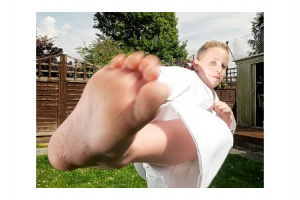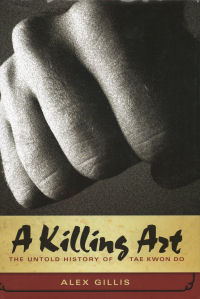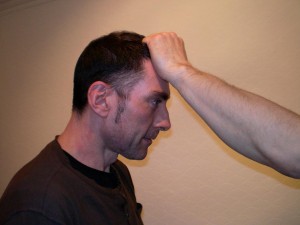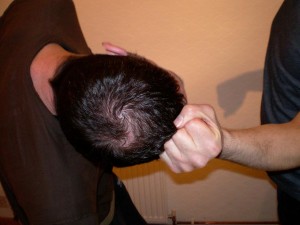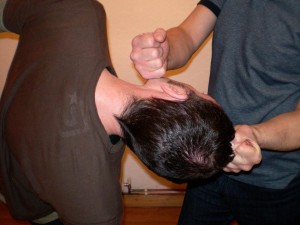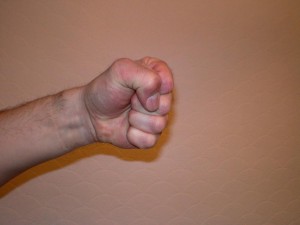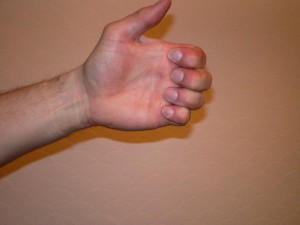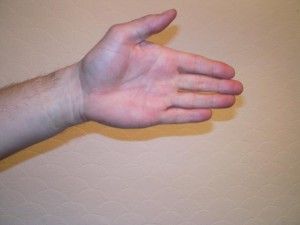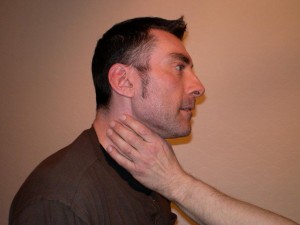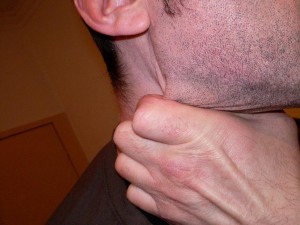Taekwondo Master Ray Gayle, 8th Dan is a former British and European champion, Chairman of the Professional Unification of Martial Arts (PUMA), inspiration to many and general all round nice guy 🙂
As well as achieving great success in the sporting side of his art, he also has a very strong leaning towards the spiritual and self development side of martial arts as a whole. This was one of the main reasons for my interest in interviewing him. I have several friends within PUMA and it is clear from talking to them (and from their Facebook conversations) that PUMA has a very strong “family feel” to it. Although there is an obvious hierarchy (as in any martial arts organisation), it is more relaxed and open than most others. If you follow Master Gayle’s writings for a while, you’ll soon notice that he takes his training and teaching seriously, but does not take himself too seriously, which I always think is a good thing. There is always a sense of humour present which you’ll see as you read on.
I was told by one of his instructors some years ago, that at a meeting of senior Taekwondo masters from different organisations within Britain, most of them had very posh expensive cars, big houses and holiday homes overseas. Yet they were surprised that Master Gayle, despite leading a very large organisation, did not have all the wealthy trimmings that they had. This (as was explained to me by his instructor) was because Master Gayle is more focused on what he puts IN to his organisation rather than what he can get OUT of it! That in itself deserves respect in this day and age.
OK, so over the interview:-
CW: Master Gayle, please tell us how you first got involved in martial arts. Was Taekwondo your first style, or did you dabble with others before that?

RG: No, Taekwon-Do was not my first style. I first started with Karate in the mid 70’s. The style that I did was Higashi-Ryu, the head of that group at that time was Mr Peter Spanton. I trained there for a short time and it was great. The School in Bristol that I attended had some really good Karate students and I enjoyed every session. It wasn’t until a couple of years after that I saw a poster with two men jumping in the air kicking each other and at the top it had the name Taekwon-Do. I’d never heard of it before and decided to go along and see what it was about. I really enjoyed watching the class and it seemed to stir something inside of me that I didn’t feel with my Karate class. I don’t think it was a style thing, just the whole feel of the class. It was also better located to where I was living, as a youngster with no form of transport that was a big plus.
CW: What did you especially like about Taekwondo for it to captivate you for so many years (or should I say decades)?

RG: It was the dynamic side of TKD, which instantly appealed to me. Anyone that knows me will know that I love the dynamic side of TKD, the jumping spinning etc, although these days I’m not so dynamic, I have to keep my jumping and spinning for special occasions now. I noticed that there seemed to be a lot of smaller guys doing it too. I don’t know if that was just coincidence, but being a little vertically challenged myself, I seemed to fit in fairly well. I love movement of all kind, dancing, tumbling etc, so on a subconscious level it was certainly something that drew me in. I was also taken by the sheer variety of the class, there seemed to be more elements to it than the Karate class that I attended, I’m not sure if that was just an illusion but that’s how I saw it. I feel that style has very little to do with what martial art you end up doing. In my opinion, the class location, the style of teaching and the initial warmth of the instructor and students are more important.
CW: You have had a very successful tournament career in your younger days, can you tell us about that please. Which victories stand out most for you and how did they affect your personal growth within Taekwondo?
RG: I really enjoyed my tournament career; it was never what I was solely about though. I loved to do TKD not just for tournaments, but also for the whole package. I consider myself to be very competitive, I would always try and do my best with all the physical activities that I took part in, so tournaments

just fuelled my competitive personality. I was actually a keen footballer and played at a very high level as a defender. Many times attacking players would look at me and I’m sure in their mind they must have thought, “I’m in for an easy afternoon.” How wrong they were, and what a shock they got. Even though I was a very small player, I did surprise lots of players who thought I was a push over; they soon learned that the fight in the man was much bigger than the man in the fight.
This will sound strange but I have no stand out fights, I loved them all. I wasn’t really a scalp and name collector; I just enjoyed the buzz of competition and always tried to compete for the fun of it and with a smile. I didn’t mind losing as long as I knew that I had performed my best. However, competitions did help with my personal growth. Growing up as a black boy in the 70’s could be tough at times. TKD competition gave me a strong self-belief that has certainly helped me not just in competition but also in other areas of my life.
CW: As a Karateka myself, I know that Karate competitions have changed quite a lot over the years with more health and safety regulations (early competitions were a little bit “Wild West”). Do you feel that Taekwondo competitions have changed much over the years and if so, are the changes for the better or for the worse? Do you also feel (generally speaking) that standards and attitudes of the competitors have changed?
RG: Good old ‘health and safety’ has got a lot to answer for. It’s certainly had an impact on martial arts and a huge impact on competition. I think in many cases to the detriment of the art. In the earlier days of competition you had to be committed, because you knew if you weren’t, the chances of getting hurt was much higher. When I started competing, safety equipment was not compulsory and there were no weight categories, that does seems bazaar now, but I feel it did make you into a better martial artist. You knew that if a kick was travelling towards you, there was no option but to block it, there wasn’t a nice comfy foam pad on the end of it taking away the impact of it. If you didn’t block, there was a very high probability you were going to get hurt. Somehow that did seem to improve the quality of the techniques thrown; there were not so many throwaway kicks or punches. Nowadays, on the plus side for TKD, the average student has much better flexibility, and the training methods for competition are a lot more scientific, I think this has also resulted in a lot less injuries.
CW: Some people are critical of Taekwondo becoming an Olympic sport, saying that it over emphasises the sport side of the art and detracts from the original values of the martial art. How do you feel about this? I know that you personally put a lot of emphasis on personal development and taking part rather than just winning; do you feel that the sport side is good for personal development or does it just develop a big ego?
RG: I have to say, I am one of those people who is very critical. Olympic TKD only shows the fighting side of the art and there is so much more to TKD than fighting. It would be lovely to have a balance and have pattern competition too, or perhaps some special technique destruction.
I think the jury is out on the ego part of the question. I believe a lot depends on how the student is developed and the role models they have around them within their own organisation and their class. I strongly believe in the power and the association of others. If the people around you are behaving in a certain way, chances are very high you will start behaving that way too. I always tell my students to try and treat winning and defeat in the same way. If you do win, the most important thing to remember is to respect your competitor and to win with humility. Unfortunately we don’t live in a perfect world and no matter what you say or do, there will be students whose ego will run away with them and they’ll begin to show the ugly side of competition.
CW: I believe that you were actually graded for your 6th Dan by General Choi Hong Hi (the founder of Taekwondo) himself. That must have been a fantastic moment for you. Please tell us about that and what this iconic man is like to actually meet in person?
RG: Yes, I took my 6th degree under General Choi in September 2000. It was a very humbling, frightening and exciting experience all at the same time. I have to say that I had a really awful grading that day. I graded at the end of a three-day seminar where he had just introduced the ‘sine wave’ style of patterns to all the P.U.M.A. members, me included. I had also just left my previous organisation so there was a lot happening around that time and a lot of mixed emotions. It was such a great experience to meet him and he was a real gentleman. There were many stories doing the rounds about how he was difficult to get on with and how he had torn strips of individuals for no reason. I didn’t find this was the case at all, I found him very easy to get on with and his passion for Taekwon-Do and his enjoyment in teaching his beloved martial art was very evident for everyone in attendance to see. He even invited a few of us out for dinner.

We had a great time chatting to him about Taekwon-Do and some of his experiences he had encountered over his many years he had been spreading the word. I guess that’s what you do when you dine with the founder of Taekwon-Do, you talk about Taekwon-Do. As mentioned, my grading was a bit of a disaster; I think he took pity on me because he could see I was giving it my best shot but obviously struggling to get it right. He knew that I was one of the senior members of the newly formed P.U.M.A. organisation, so during the questioning part of my grading, he gave me some guidance as to how I should lead the group. He said that I should read and study Confucius and try and follow some of the teachings to enable me to be a better leader. I can honestly say that the weekend seminar and taking my grading under the General changed my life. It also changed the way I approached my Taekwon-Do and how I would teach it from then on. I was honoured that I got to chat with him privately on a one-on one basis, I was overwhelmed by his passion for Taekwon-Do, he must have talked for two hours about his thoughts on how Taekwon-Do should be taught and the difference that it could make in the lives of so many students.
When I found out I was successful in passing my 6th degree, I did vow to myself that when the time came to grade for my 7th degree, I would do everything in my power to take it in front of him, just so I could show him the progress I had made since my 6th degree. Unfortunately, I never got that chance to grade in front of him again as he passed away in June 2002. However, I did attend a Master’s seminar with him in January 2002 in Vienna. I couldn’t wait for the seminar to start so I could show him how much I’d learnt in 18 months since I graded. He did give me a few nods of approval and that made me feel really good.
CW: You’ve recently been awarded your 8th Dan, a dizzy height that not many Westerners reach. Congratulations Sir! Not knowing much about the Taekwondo world, was that expected, how did it come about and what does it mean to you personally?
RG: I was awarded my 8th degree on the weekend we held our second World Open competition. I had it sprung on me during a brief break for a medal ceremony, It was extremely unexpected. I knew nothing about it whatsoever, if I had known it was going to happen I would certainly have objected and perhaps not even turned up that weekend. It was something that I wasn’t looking for and would have been very happy to remain a 7th degree for many more years. When I started Taekwon-Do it was always said that to achieve the higher degree grades it wasn’t what you could do physically that counted, but it was what you did for the art of Taekwon-Do and other people that would determine if you were awarded those higher degrees. I’ve never forgotten that, although the things that I’ve done were because they needed doing not with a higher degree grade in mind. Perhaps the thing I’m most proud of which many state as one of the reasons I was considered for that promotion, is my continual involvement and development of Martial arts in West Africa, specifically Ghana.
CW: Having been an instructor for many years, you’ll have seen an awful lot of people, many of whom would have started as little children, growing physically and mentally as they achieve success in championships and reaching black belt (and beyond). How important is it to you personally to see this growth in other people and do you have any favourite stories/examples of people overcoming many obstacles to achieve success through their training?
RG: Yes, I’ve seen real transformations in many children over the years. I have seen children with absolutely no confidence at all grow into confident adults with a real positive outlook and a strong self-esteem. However, I don’t think martial arts is unique in the way it can build these qualities, I think that Taekwon-Do and martial arts in general is just one of many vehicles that can have such an effect. I strongly believe its more about the teacher and the environment in which the teaching and learning is taking place, than about the vehicle. After all, the qualities that are taught in most traditional martial arts are the same qualities that would be taught to anyone practicing any organised religion. Also a child who learns to master a musical instrument would certainly have their self-esteem and self-confidence boosted and would feel so much better about themselves. It would give them the ability to do other things that they might not have attempted before. I wouldn’t say that I have one special example over another, but needless to say, I think a large proportion my students who started at a young age and have achieved higher levels have benefited from their training. In recent years I’ve had students contact me many times over to thank me for helping them build their self-confidence. They have said that the personal growth that they achieved through training, allowed them to pursue and follow their dreams.
CW: What do you consider the most important benefits of training for martial artists of any style?
 RG: I think the most important benefit of training a martial art, depends on what the students is looking for in the first place. There are so many reasons why people decide to start a martial art, I think that question is best served by asking the individual. There are the obvious benefits that include, fitness, self-defence, confidence, mental and physical development etc, but also the not so obvious which might include, escapism, social interaction, an alternative to the usual physical pursuits that people might choose to keep fit. The list is as long as the different types and personalities of the students that begin a martial arts lifestyle.
RG: I think the most important benefit of training a martial art, depends on what the students is looking for in the first place. There are so many reasons why people decide to start a martial art, I think that question is best served by asking the individual. There are the obvious benefits that include, fitness, self-defence, confidence, mental and physical development etc, but also the not so obvious which might include, escapism, social interaction, an alternative to the usual physical pursuits that people might choose to keep fit. The list is as long as the different types and personalities of the students that begin a martial arts lifestyle.
CW: Although I’ve never actually met you before, I’ve noted that you have a very philosophical and spiritual approach to life. Have you always been like this, or is it a side of you that has developed as you’ve matured? To what extent have your years of Taekwondo influenced you on your spiritual path?
RG: I haven’t always been like this and yes, it’s certainly something that seems to have developed as I’ve matured in Taekwon-Do. When I was a younger martial artist, my main focus was on being the best physical martial artist I could be. I was focused on kicking and jumping higher, doing more press-ups, being stronger and faster than I was the week before. Once you grow out of that and realise that there is a lot more to life, you start to look at the big picture, and in my opinion you start to find the real meaning of martial arts. I’m not saying that you should just ignore all those other things, its important to still stay physically strong and active, but I feel its a natural process to take a much more philosophical approach to life and training as you mature. I still get a good buzz from doing the physical stuff that was one of the things that I enjoyed about training in the early days. Leaving the dojang knowing that I’d done two more press-ups than the week before was, and still is, a great feeling. I realise now though that training and teaching a martial art without some emphasis on the spiritual side and philosophy behind it, just makes it the same as any physical pursuit. If at some point in your training that side is not recognized, you may as well just go and do a zumba class.
CW: Do you have many influences outside of Taekwondo that have supplemented this spiritual development and are there any books, DVD’s or any other source material that you would recommend to those interested in learning more?
RG: I have the usual collection of books that perhaps most are familiar with. Book of Five Rings, The Samurai Code, I have some great books by HRH Dalai Lama. I also have a whole host of self-development books by many different motivational speakers. My favourite motivational speak is, Zig Ziglar. Probably my favourite book on the spiritual side of martial arts is; Kodo Ancient Ways, lessons in the spiritual life of the warrior/martial artist, by Kensho Furuya. This is a great book that I stumbled across a few years ago. It is written by an Aikido Master, however, it contains lessons and teachings that are relevant to all martial art disciplines. There are some fantastic philosophies and some great paragraphs that make you examine your training, your thinking and yourself.
This is a particular favourite passage of mine from the book;
“If you think strength is the most important factor in martial arts, you will never be strong.” “A common person may become a master,” a true master never becomes a master.” Because learning and mastery is endless.
Of course my biggest influence outside of martial arts for spiritual development, has been my mother. What a warrior she’s been. What a great leader and philosopher of life she has been to me. She taught me how to live and how to fight without even entering a dojang. When I started my martial arts training I already had a head start because of the lessons I’d learnt at home from my mother, a true champion.
CW: When you and life long friend, Master Ogborne (former World champion) set up the Professional Unification of Martial Arts, what were your main objectives and to what extent do you feel that you’ve achieved them?


RG: To be completely honest, when we left our previous association, it wasn’t our intention to set up the Professional Unification of Martial Arts (P.U.M.A.) It certainly wasn’t by design that it happened as it did. Master Ogborne and I have been life long friends, so our only intention at that time was to leave and be independent with just the few Schools we were teaching at that time. Soon after leaving we had many people contact us asking if they could join us, it was as simple as that. I’d like to tell you there was a lot more to it and how we sat down with a large pad and paper and planned it all out, but we certainly didn’t.
CW: P.U.M.A. now covers Taekwondo, Tang Soo Do, Kickboxing & FAST Defence. Do you have any plans to expand the range of arts covered and what are the requirements for other styles/arts joining P.U.M.A?
RG: We’ve never had any plans to expand, we’re very happy with how P.U.M.A. is right now. As far as I’m concerned, if there is any expansion of P.U.M.A, I’d like it to be from within the organisation rather than from outside. I feel that the students who have grown up with us know what we’re about and are familiar with the P.U.M.A. ethos. Whether it’s stated or not, I believe that every martial arts group or association has an underlying ethos, it runs through their day to day interaction with students and underpins everything that happens. The ethos within the group has to come from the senior degree grades and filter down to the junior students. That’s why I’m very wary of trying to expand from outside, if the ethos is not understood, then the result will be disharmony and the union of Schools and minds won’t work.
CW: Having attended a FAST (Fear, Adrenalin, Stress Training) Defence course myself with P.U.M.A.’s very own Dik Chance, I can honestly say that I find this type of Reality Based training very useful. Many traditional martial arts associations don’t like to include this kind of thing as I guess they don’t want to admit their training might conceivably be lacking in any areas at all, so I applaud your foresight in this area. Has the inclusion of FAST Defence within P.U.M.A changed your outlook at all on the basic self defence value of traditional martial arts?
RG: I can’t say it has changed my personal outlook, more reinforced what I thought for a long time. I first saw the FAST defence system while at a martial arts convention in America. I was with other senior members of P.U.M.A. as soon as we saw the system and how it worked, it was obvious to us that it could be of great benefit to us and to the members of our group. Personally for me, it was the children’s FAST defence system that really stirred my imagination.
I’ve always thought that self-defence in its basic form is very simple, also being small of stature, a lot of the release moves and locks and holds which different systems teach, never really excited me. The thought of me at 11 stone and 5’6″ trying to release, after being grabbed by a 16 stone 6’4″ male with some of those techniques were a little far fetched. I’m not saying they don’t work for some people, just that for me, it would present a huge challenge. The verbal techniques and simplified counters of F.A.S.T. defence made perfect sense, and when I first saw it, my impression was that it could be employed by anyone regardless of size or strength. The FAST system has enabled P.U.M.A. members and others to experience the psychology of self-defence in a controlled environment, surely that can only be a good thing.
CW: Obviously I’m not part of P.U.M.A. myself, but I have a number of friends within P.U.M.A. One of the things I’ve noticed (especially from the Facebook banter) is that P.U.M.A. seems to have the feel of a big happy family with a lot of friendship and links between the different Schools (rather than rivalry). How do you foster this atmosphere and feeling within your association?
RG: In all martial arts associations there is a hierarchy. At the top you have the more senior grades who have generally been around for the longest time, right down to some of the young children just starting their own journey. I try to acknowledge all of our members and to be approachable at all times, I believe that this approach fosters a real family atmosphere rather than the fearful environment that I’ve seen in some groups. For an art that has courtesy as its’ first tenet, there are many organisations that don’t have the courtesy to give their members the time of day or even talk to them in a civil manner. Just the act of smiling can make a huge difference to someone’s day. It’s a cliché, but saying hello with a smile doesn’t cost anything, but it does mean so much to the person receiving it.
CW: I note that P.U.M.A has got very involved in supporting a project in Ghana (which you mentioned earlier). Can you tell us how you got involved with this, what you plan to achieve, what your future commitment will be and why it is important to you personally?
RG: The Ghana project is very close to my heart and I’m happy to say it’s also close to the heart of a fair few P.U.M.A. students too.  About six years ago, I was asked to accompany Master Trevor Nicholls to Ghana to assist with helping a group transfer from WTF to ITF Taekwon-Do, ever since then I’ve been involved with helping them develop their martial arts and their organisation. My first visit was a real eye opener and laid the seeds for what was to come. While there, I saw some very passionate people who needed a hand to develop their Taekwon-Do, they had asked for help from many people and each time it seems they were let down. I think the main reason they were let down by others is because there’s no money to be made in helping them. Sad, but I believe true. A very likeable young man, Mohammed Mahadi 4th degree, leads the Ghana group. As a young lad he studied Karate and then moved to WTF Taekwon-Do. He eventually became disillusioned with the help he was getting from the WTF and decided to change to the ITF to see if they were willing to do more for the West Africa region. As soon as I went to Ghana I fell in love with the people and the country, so my passion for seeing them progress was born and has continued with many visits since. At present we are helping them to build a dojang to enable them to spread the martial arts word to as many people as possible.
About six years ago, I was asked to accompany Master Trevor Nicholls to Ghana to assist with helping a group transfer from WTF to ITF Taekwon-Do, ever since then I’ve been involved with helping them develop their martial arts and their organisation. My first visit was a real eye opener and laid the seeds for what was to come. While there, I saw some very passionate people who needed a hand to develop their Taekwon-Do, they had asked for help from many people and each time it seems they were let down. I think the main reason they were let down by others is because there’s no money to be made in helping them. Sad, but I believe true. A very likeable young man, Mohammed Mahadi 4th degree, leads the Ghana group. As a young lad he studied Karate and then moved to WTF Taekwon-Do. He eventually became disillusioned with the help he was getting from the WTF and decided to change to the ITF to see if they were willing to do more for the West Africa region. As soon as I went to Ghana I fell in love with the people and the country, so my passion for seeing them progress was born and has continued with many visits since. At present we are helping them to build a dojang to enable them to spread the martial arts word to as many people as possible.
Fast forward a few years and in Ghana I have been involved with taking a team of youngsters there to demonstrate at local orphanages, I’ve met and had an audience with some of the most important tribal chiefs to ask them for their help and support to establish martial arts in West Africa. I’ve taken a team of fighters there to compete and promote TKD. While there, I’ve visited companies to try and rally support as well as finance for the local students. I’ve met the Ghanaian chief of Police and managed to help with the promotion of teaching martial arts to all the Ghanaian Police recruits.
CW: Amongst the fundraising events for the Ghana project you led a team of the P.U.M.A. faithful on a sponsored cycle ride from John O’Groats to Lands End. This is no minor achievement, please tell us all about it?
RG: The reason for the ride was to raise money for 3 charities in which we have a personal interest. The first was the P.U.M.A Ghana project that I’ve already mentioned. The second was for a group called ‘Pilgrim Bandits,’ that is run by an old Taekwon-Do friend from the past. Pilgrim Bandits look after and support servicemen and women who have been injured while on active service. The third was for a charity called Friends of Valence. They are a School in Kent who support and help children and adults with additional needs. One of our instructors has a son who has attended and been helped by the School. So all the charities were very worthwhile and in some way or another we had a personal interest in them. I’m happy to say that the ride was my idea. What a great time we had, 12 days of pain made easier by the great company of some of my fellow PUMA martial artists. Of course being the elder statesman of the ride, they made sure that I was in front leading the team at all times, well that’s not quite how it went. Needless to say when we got on our bikes degree grades didn’t matter and it was every man for himself. In truth, we all helped each other out during the tough times that we all experienced at some point during the twelve days. I think that we all learnt a great deal about each other and it brought us all closer together as people. There’s something about experiencing pain as a group that brings that group closer. With the portion of the Ghanaian proceeds, along with an offer of land from one of the chiefs, we have nearly completed the building of a training centre for the students of West Africa where they can come and train for free to expand their knowledge of their art. It has been a tough few years but the fruits of our labour are now being seen and hopefully the Ghanaian students will be able to have some of the benefits that we enjoy and take for granted.
I’d like to publicly thank the following people for helping us all to realise the PUMA Lands End to John O Groats dream. The cyclists: Mr Dan Lammin 5th degree, Mr Ian Bedborough 5th degree, Mr Chris Walker, 4th degree, Mr Tony Goodwin 3rd degree. P.U.M.A. support vehicle: Mrs Tracey Bedborough 3rd degree, Mrs Tamzin Goodwin 3rd Degree. I haven’t told them yet but I do plan to do it again. Shh!

CW: OK, I won’t tell anybody 🙂 You have taken number of your senior instructors to Ghana to personally get involved in teaching a range of Ghanians from different backgrounds. This has on occasion involved considerable personal discomfort for those involved. On a personal level, what have you and your senior instructors gotten out this unusual experience?
RG: As mentioned previously, the Ghana project is still ongoing and every year I give P.U.M.A. instructors the opportunity to travel with me to experience teaching and training in Ghana and also to meet the wonderful Ghanaian people. You’d really have to ask the people that have come with me what they feel they’ve gained from their experience, but I’m sure they would also say that it has changed their life. The Ghanaian people are the friendliest people you could ever meet and although considerable poverty exists within the country, their hospitality is second to none. The smiling faces that you see throughout the country are testament to their incredible will and determination to live a contented life. I think what you get as someone who has grown up with certain luxuries, is a sense that we would certainly all be happier with less. When I get home after each visit some of the things I thought were important seem very trivial indeed.

CW: Since founding P.U.M.A. you’ve continued to evolve your Taekwondo with inclusion of things like the sine-wave movement for example. What are your plans for the future direction and development of P.U.M.A. in terms of how you teach/apply Taekwondo and expand as an association?
RG: I think for me, my main focus for the future is to continue producing good students who are technically competent but also have a social conscious too. I believe that our main focus shouldn’t just be about producing champions who can kick and punch, but also developing people who are passionate about upholding the Taekwon-Do oath and who are constantly trying to get closer to the tenets of our art. Regarding expansion, if students come through our system and want to be instructors, then I’m happy to help and assist them reach their goals. I have no immediate plans to change our direction, as a group we’re very happy with our current position within the world of Taekwon-Do
CW: Many people feel that Taekwondo is not necessarily good for the body as we get older due to the emphasis on high kicking. Do you agree/disagree? Do you believe that people should adapt their training as they get older, or should they just try to keep up? Have you personally had to adapt your training very much as you’ve matured?
RG: That’s a question that could take many pages to answer, I’ll try and take the short route though and make it quick. There are so many answers to this question but first I must say that I do believe you can train in TKD as you get older but just like any physical discipline small adaptations are probably needed to keep your body safe as you age.
 How safe it is will depend on the individual and how they approach their regime. I also think that as you get older its not enough to just change the physical aspect of your training, other aspects like diet and general lifestyle need to be adjusted too. If the student has a good level of flexibility then I see nothing wrong in trying to retain it. If flexibility is a challenge for them then they might have to approach flexibility training with some caution. I’m not sure that kicking high should be the goal, kicking correctly should be the first goal and if they can kick high that’s a bonus. I’ve had to adapt my training for a more sensible scientific approach because of a hip operation I had approximately six years ago, so I’m very well aware of trying to keep my body safe and in good health.
How safe it is will depend on the individual and how they approach their regime. I also think that as you get older its not enough to just change the physical aspect of your training, other aspects like diet and general lifestyle need to be adjusted too. If the student has a good level of flexibility then I see nothing wrong in trying to retain it. If flexibility is a challenge for them then they might have to approach flexibility training with some caution. I’m not sure that kicking high should be the goal, kicking correctly should be the first goal and if they can kick high that’s a bonus. I’ve had to adapt my training for a more sensible scientific approach because of a hip operation I had approximately six years ago, so I’m very well aware of trying to keep my body safe and in good health.
CW: You are married with 4 kids. Do they all do Taekwondo? How does Taekwondo affect your family life and how does your family life affect your Taekwondo?
RG: Two of my four children currently train in TKD. I have a 26-year old son who trained from the age of 8 until he was 18. When he went to university I think he lost the habit and decided to stop, he achieved his 2nd degree, you never know though he may return to it one day. My second son who is 21 still trains regularly and is now a 3rd degree. I’m very proud of him as he still helps in my class teaching the youngsters. He trains hard and is much liked throughout the organization. I also have two girls one 6 and the other is 3. My 6 year old has started training and loves every minute of it. I’m hoping that my 3 year old will start when she reaches the age of 4. My Partner Is a 5th degree and has been training in TKD for 24 years, so she is aware of my passion for Taekwon-Do and what it means to me.
To answer your question, Taekwon-Do is a huge part of my family life, and vice versa. I don’t think doing what I do it can be any other way. There are some challenges but I know I have the full support of my family. Whenever possible my family come to the events within our organization and they also accompany me to our training camps etc. My partner has found it difficult to train consistently over the past 6 years because she has done most of the childcare during that period. She is currently trying to begin a regular training routine again; she’s really looking forward to getting back to it.
Taekwon-Do does have a big impact on my family but I see that as a huge positive.
CW: Master Funakoshi who taught General Choi used to recommend that his students do something artistic to balance their martial training. He wrote poetry. I believe that you’re a bit of a musician. How big a part of your life is music and do you find that it helps to balance you with your Taekwondo training?
RG: I think the advice from Funakoshi was great advice. Life is all about balance and no matter how much we love doing something, getting away from it for a short time and doing something completely different can have  a positive effect when we get back to our pursuit. I sing and play harmonica in a local band and it’s certainly the yang to my regular TKD routine. I love to get away and play. The people who I usually play with or in front of know what I do, they just know me as Ray who sings and plays harmonica in the band. As well as doing my regular TKD practice, I always try and fit in some daily harmonica practice too. It keeps me balanced and has a real meditative effect on my life.
a positive effect when we get back to our pursuit. I sing and play harmonica in a local band and it’s certainly the yang to my regular TKD routine. I love to get away and play. The people who I usually play with or in front of know what I do, they just know me as Ray who sings and plays harmonica in the band. As well as doing my regular TKD practice, I always try and fit in some daily harmonica practice too. It keeps me balanced and has a real meditative effect on my life.
CW: What do you think is likely to happen in the future of Taekwondo as a whole? Obviously there are many different associations and versions of Taekwondo now, do you see more cooperation for the common good, more fragmentation, or simply people just doing their own thing?
RG: The day that General Choi died was the day that TKD changed forever. After the initial fragmentation when he passed away, I think the last few years has seen a steady tide of cooperation between groups. If there are enough people willing to work together, then I think that’s a good thing and there is certainly some hope for the future of our art. I’d like to think that however it goes I’ll still remain as I am and continue to teach Taekwon-Do using the General’s teaching and philosophies to underpin my own teaching. The great thing about teaching any martial art, is that you can bring your own personality into the training hall. For me it doesn’t matter what the others do, I’m going to continue doing exactly as I’m doing now, loving and teaching the art in the way I know best.
CW: Master Gayle, thank you for a very interesting and insightful interview. I know that you’ve had a lot of personal challenges lately, so thank you for taking the time to answer all my questions. I wish you, your family and all your students every success on your future journeys. Take care.
Note: It is planned to reproduce this interview in the on-line magazine, Totally Taekwondo. This is a non-political Taekwondo magazine for TKD practitioners of all associations and I thoroughly recommend it to anybody interested in TKD.

